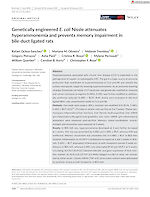Background and Aims: Hepatic encephalopathy (HE) is a neuropsychiatric syndrome with symptoms ranging from impaired reaction time, poor memory to asterixis, gross disorientation, lethargy and coma. HE is a major complication of chronic liver disease (CLD) and develops when the hepatic capacity to detoxify ammonia is decreased. During this condition, muscle plays a compensatory role removing ammonia, but muscle mass loss further reduces the capacity to metabolise ammonia and hyperammonemia prevails. HE is marked by an increase in brain water caused via the synergistic effect of ammonia and oxidative stress (reactive oxygen species (ROS)). Brain edema and ammonia-related cognitive impairments as well as muscle mass loss have been well described in male rats with CLD but have not been explored in female CLD rats. Therefore, our aim was to identify whether sex influences brain edema and ammonia-mediated cognitive impairments. Methods: Five weeks after either bile-duct ligation (BDL) (n=8) or Sham (n=8) surgery in male and female rats, we assessed markers of liver injury and function, body parameters (weight, composition (MRI), gastrocnemius muscle weight/circumference and grip strength), HE (open field test for anxiety, rota-rod test for motor coordination and night-time activity) and brain edema (by gravimetric density method). Finally, we assessed susceptibility to develop severe cognitive impairment (mild-moderate lethargy, ataxia and loss of righting reflex) in male and female BDL rats after an ammonia challenge (6 mmoles/kg of ammonium acetate injected subcutaneously). Both plasma ammonia (Randox kit) and ROS (2',7'-dichlorodihydrofluorescein diacetate test (DCFDA)) were investigated. Results: Female BDL rats, similar to male BDL rats, had CLD, with impaired liver markers (ALP (p<0.001), AST (p<0.001), bilirubin (p<0.0001) and albumin (p<0.001)) compared to respective Sham controls. Male BDL rats experienced loss of lean mass (p<0.001), muscle weight (p<0.01) and strength (p<0.01) while similar differences were not found in female BDL vs respective Sham controls. Both female and male BDL developed HE (impaired motor-coordination (p<0.05) and reduced night activity (p<0.05)), compared to respective Shams. However, contrary to male BDLs, female BDLs did not develop brain edema compared to respective Sham controls. When compared to male BDL, baseline plasma ammonia levels did not differ to female BDL rats. However, plasma ROS levels were lower in females compared to males (p<0.05). Following ammonia challenge, male BDL rats had progressive worsening of mental status, reaching ataxia and loss of righting reflex while female BDL were protected, reaching only moderate lethargy (p<0.05). During the ammonia challenge, female BDL rats had similar ammonia levels but lower levels of ROS compared to male BDL rats (p<0.01). Discussion: We demonstrated BDL surgery in females leads to hepatic and neurological impairment comparable to male BDL rats. Contrary to males, female BDL did not develop loss of muscle mass nor brain edema compared to respective controls. However, sustained muscle mass in females did not lead reduced blood ammonia therefore the protection versus brain edema in females in due to protection against systemic oxidative stress. Female BDLs did not developed severe HE following ammonia challenge. Whether brain edema or systemic oxidative stress renders the females resistant to ammonia insults remains to be determined.






































